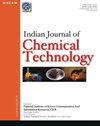Amalgamation of copper nanoparticles of assorted size using Nelumbo nucifera (lotus) leaf and its bioelectrical assay
IF 0.5
4区 工程技术
Q4 CHEMISTRY, APPLIED
引用次数: 0
Abstract
There are several potential uses for green nanoparticle amalgamated in the medicinal and environmental sciences. Green synthesis specifically tries to reduce the use of harmful chemicals. For instance, it is often acceptable to employ organic resources like plants. In a single green synthesis step, biomolecules found in plant extract may transform metal ions into nanoparticles. This naturally occurring conversion of a metal ion to a base metal may be carried out quickly, conveniently, and at ambient temperature and pressure. In the current study, the production of CuNPs utilizing different-sized Nelumbo nucifera leaf extract has been reported. In order to determine how CuNPs generated, several techniques including UV-Visible, XRD, SEM, EDAX, FTIR, and cyclic voltammetry studies were used. The UV-Visible spectra of the amalgamated CuNPs show a peak between 250 and 450 nm. The morphology of CuNPs are spike in shapes with sizes of 33nm for 10mM and 25nm for 50mM, and the nanoparticles are crystalline in nature, according to the XRD and SEM examinations. The amalgamated CuNPs contain 37.55% copper, according to EDAX, and FTIR shows the absorption peak of copper at 1640 and 576 cm -1 .The oxidation and reduction of amalgamated CuNPs are visible by cyclic voltammetry. CuNPs have been put to the test against Staphylococcus aureus, Staphylococcus epidermidis, Klebsiella pneumoniae, Escherichia coli, and Pseudomonas aeruginosa for their antibacterial properties. CuNPs show the greatest zone of inhibition when used against Pseudomonas aeruginosa . Aspergillus flavus and Candida albicans have been used as test subjects for the antifungal testing of CuNPs. The CuNPs against Candida albicans show the largest zone of inhibition. CuNPs demonstrate strong antibacterial and antifungal efficacy, which means they have a considerable potential for application in the development of medications used to treat bacterial and fungal infections. The electrical potential difference of amalgamated CuNPs has been measured using a voltmeter and it is found that as concentration rises, so does the electrical potential difference.不同大小的铜纳米颗粒在荷叶中的融合及其生物电学分析
绿色纳米颗粒在医学和环境科学中有几种潜在的用途。绿色合成特别试图减少有害化学物质的使用。例如,使用植物等有机资源通常是可以接受的。在单一的绿色合成步骤中,植物提取物中的生物分子可以将金属离子转化为纳米粒子。这种自然发生的金属离子到贱金属的转化可以在环境温度和压力下快速、方便地进行。在目前的研究中,已经报道了利用不同大小的荷叶提取物生产乳香多糖的方法。为了确定CuNPs是如何生成的,使用了几种技术,包括uv -可见,XRD, SEM, EDAX, FTIR和循环伏安法研究。其紫外可见光谱在250 ~ 450 nm之间有一个峰值。XRD和SEM分析表明,纳米颗粒为晶体状,粒径为33nm (10mM)和25nm (50mM)。经EDAX测定,铜的含量为37.55%,FTIR在1640和576 cm -1处发现了铜的吸收峰,循环伏安法可观察到铜的氧化和还原。CuNPs对金黄色葡萄球菌、表皮葡萄球菌、肺炎克雷伯菌、大肠杆菌和铜绿假单胞菌的抗菌性能进行了试验。当用于铜绿假单胞菌时,CuNPs显示出最大的抑制区。以黄曲霉和白色念珠菌为试验对象,对其进行了抗真菌试验。对白色念珠菌的抑制区最大。CuNPs显示出强大的抗菌和抗真菌功效,这意味着它们在开发用于治疗细菌和真菌感染的药物方面具有相当大的应用潜力。用电压表测量了其电位差,发现随着浓度的升高,电位差也随之升高。
本文章由计算机程序翻译,如有差异,请以英文原文为准。
求助全文
约1分钟内获得全文
求助全文
来源期刊

Indian Journal of Chemical Technology
工程技术-工程:化工
CiteScore
0.90
自引率
20.00%
发文量
17
审稿时长
6-12 weeks
期刊介绍:
Indian Journal of Chemical Technology has established itself as the leading journal in the exciting field of chemical engineering and technology. It is intended for rapid communication of knowledge and experience to engineers and scientists working in the area of research development or practical application of chemical technology. This bimonthly journal includes novel and original research findings as well as reviews in the areas related to – Chemical Engineering, Catalysis, Leather Processing, Polymerization, Membrane Separation, Pharmaceuticals and Drugs, Agrochemicals, Reaction Engineering, Biochemical Engineering, Petroleum Technology, Corrosion & Metallurgy and Applied Chemistry.
 求助内容:
求助内容: 应助结果提醒方式:
应助结果提醒方式:


